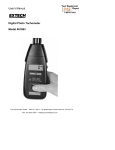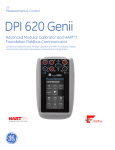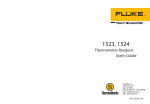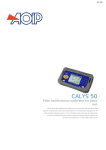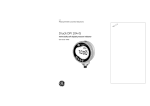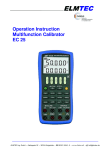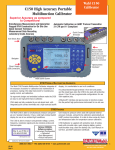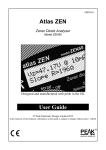Download Manual - Test Equipment Depot
Transcript
GE Infrastructure Sensing 99 Washington Street Melrose, MA 02176 Fax 781-665-0780 TestEquipmentDepot.com Druck DPI 811/812 RTD calibrator and RTD loop calibrator User manual - K345 A1 B1 10 10 A2 1 9 A3 8 2 7 3 6 11 4 5 B1 12 A2 DPI 812 13 15 14 A3 19 18 17 16 27 20 21 22 23 26 24 25 K345 Issue 2 Test Equipment Depot - 800.517.8431 - 99 Washington Street Melrose, MA 02176 FAX 781.665.0780 - TestEquipmentDepot.com Customer service Visit our web site: www.gesensing.com Table of Contents Introduction Introduction ......................................................................... 1 Safety ..................................................................................... 1 Safety - Marks and symbols on the instrument ............... 2 To start .................................................................................. 2 To start - Location of items ........................................................ 2 To start - Items on the display .................................................. 2 To start - Prepare the instrument ........................................... 2 To start - Power on or off ............................................................ 3 To start - Set up the basic operation ..................................... 3 To start - Select a task (Measure and/or simulate) ......... 3 To start - Set up the settings ..................................................... 4 To start - Edit functions ................................................................ 4 Operation .............................................................................. 6 Operation - RTD connections .................................................... 6 Operation - Communications port connections .............. 6 Operation - Measure RTD values ............................................. 6 Operation - Change the output values ................................. 6 Operation - Simulate RTD values ............................................ 7 Operation - Transmitter calibration ....................................... 7 Operation - mA measurements ............................................... 8 Operation - Switch test ................................................................ 8 Operation - UPM Pressure measurements ......................... 9 Operation - Error indications ..................................................... 9 Maintenance ..................................................................... 10 Maintenance – Clean the unit ................................................ 10 Maintenance – Replace the batteries ................................ 10 Calibration ......................................................................... Calibration - Before you start ................................................. Calibration - Procedures (Ohms input) ............................... Calibration - Procedures (Ohms output) ........................... Calibration - Procedures (mA input) .................................... Calibration - Procedures (IDOS UMM) ................................. 10 10 10 11 11 11 Specification data ............................................................ Specification - General .............................................................. Specification - Temperature ranges ................................... Specification - Resistance ranges ........................................ Specification - Electrical connectors (A2) ......................... 12 12 12 12 12 Customer service ............................................... Back cover © 2005 General Electric Company. All rights reserved. Trademarks All product names are trademarks of their respective companies. K345 Issue 2 The DPI 811 RTD (Resistance Temperature Detector) Calibrator and DPI 812 RTD Loop Calibrator are part of the Druck DPI 800 series of hand held instruments. The DPI 800 series uses Intelligent Digital Output Sensor (IDOS) technology to give instant plug and play functionality with a range of Universal Measurement Modules (UMM). Example: the Universal Pressure Module (UPM). The DPI 811/812 include these functions: Function Measure/simulate RTD temperature or resistance DPI 811 Step/Ramp functions Communications port Language selection DPI 812 * Yes Automatic/Manual IDOS or RS232 Yes Measure pressure/Leak test ** Snapshot Measure mA ** External IDOS UPM Up to 1000 displays with a date/time stamp No 0 - 55 mA HART® resistor V dc output No No Switch test Other functions No Yes Hold, Maximum/Minimum/Average, Filter, Tare, Scaled values, Backlight, Alarm * ** Yes 24 V Refer to “Specification data”. Optional item Safety Before you use the instrument, make sure that you read and understand all the related data. This includes: all local safety procedures, the instructions for the UMM (if applicable), and this publication. WARNING • It is dangerous to ignore the specified limits for the instrument or to use the instrument when it is not in its normal condition. Use the applicable protection and obey all safety precautions. • Do not use the instrument in locations with explosive gas, vapor or dust. There is a risk of an explosion. • To prevent electrical shocks or damage to the instrument, do not connect more than 30V between the terminals, or between the terminals and the ground (earth). Continued [EN] English - 1 Safety (Continued) To start - Items on the display A3 • UPM only. To prevent a dangerous release of pressure, isolate and bleed the system before you disconnect a pressure connection. Before you start an operation or procedure in this publication, make sure that you have the necessary skills (if necessary, with qualifications from an approved training establishment). Follow good engineering practice at all times. Safety - Marks and symbols on the instrument Complies with European Union directives Warning - refer to the manual Read the manual Battery Ground (Earth) ON/OFF Item 16. Description DPI 812 only. Task indication for the switch test. = switch closed Refer to: Select Task (Table 2/3) DPI 812 only. The loop power supply is on. Refer to: Select Task (Table 2/3) 17. 18. The measured value satisfies one of the alarm conditions. Refer to: Settings (Table 4) The data on the display is on hold. To continue, press the HOLD button again. 19. 20. Shows the battery level: 0 ... 100%. 21. Identifies the type of data and the measurement range. = Input = IDOS input To start To start - Location of items A1 Item 1. 2. 3. … A2 Description ❍ ■■ On or off button. 4. 5. 6. 7. 8. 9. Moves back one menu level. Leaves a menu option. Cancels the changes to a value. Increases or decreases a value. ▲ ▼ Highlights a different item. Holds the data on the display. To continue, press the HOLD HOLD button again. Shows the Select Task menu. MENU Selects or accepts an item or value. OK Selects [✓] or cancels [ ] a selection. Right-hand soft-key. Selects the function above it on ■■ the display (Item 25). Example: Settings Display. Refer to A3 SENSOR / PC 10. 11. 12. 13., 14., 15. 22. ... 24. 22. °C Left-hand soft-key. Selects the function above it on the display (Item 25). Example: Edit ESC Communications port. Use to connect a Universal Measurement Module (UMM) or a RS232 cable. RTD connectors: To measure, use the 2 Wire, 3 Wire, or 4 Wire “INPUT” connectors. To simulate, use only the two “OUT” connectors. Refer to “Operation”. Connection point for some of the optional accessories. Refer to the datasheet. Battery compartment. Refer to B1. DPI 812 only. Terminals to measure current, to supply 24V source, and to do switch tests. = switch open UPM only. Task indication for the leak test. Pt... 23. = Output Refer to: Select Task (Table 2/3) The settings applied to the input or output. The units or a specified scale (x:y) - (Table 4/5). The RTD type (Pt50, ...) - (Table 4/5). RTD input connections: 2, 3, or 4 (Figure 1) = Output operation (Table 5) , ... , 24. = Filter = Tare = Maximum = Average (Table 4) = Minimum 25. A soft-key function. To select an available function, press the soft-key below it. Example: 26. The measured value or values applicable to the task selection. The Edit display to set up text labels ( ≤ 6 characters): x:y Scaling (Table 4). = Move left 27. OK Shift BS = Move right = Accept the new text label = Change the keys: 123ABC or -_+abc = Add a space = Back space (Delete character) To start - Prepare the instrument Before you use the instrument for the first time: • Make sure that there is no damage to the instrument, and that there are no missing items. • Remove the plastic film that protects the display. Use the tag (◗) in the top right-hand corner. • Install the batteries (refer to B1). Then re-attach the cover. Test Equipment Depot - 800.517.8431 - 99 Washington Street Melrose, MA 02176 2 - [EN] English FAX 781.665.0780 - TestEquipmentDepot.com K345 Issue 2 To start - Power on or off To turn the instrument on or off, press ❍ (A1 - item [1]). The instrument does a self test and then shows the applicable data. When the power is off, the last set of configuration options stays in memory. Refer to “Maintenance”. To start - Set up the basic operation Use the Set Up menu to set up the basic operation of the instrument. 1 Menu: Select Task 2 3 Menu: Set Up ▲ ▼ (Table 2) 4 2 3 Display: RTD output ▲ ▼ Sk1 = Edit Sk2 = Settings (Table 2/3) In Table 2/3, IDOS is a Universal Measurement Module (UMM). If you attach a UMM to the communications port (A1 - item [9]), the Select Task menu shows the applicable IDOS options. [✓]/[ ] If there is additional data for a menu option, select Settings (■ ■) to see the values that are set up. If necessary, adjust the values. Table 1: Menu options - Set Up Options (If applicable) Menu: Select Task 1 5 ▲ ▼ (Table 1) To start - Select a task (Measure and/or simulate) When the instrument is set up (Table 1), use the Select Task menu to select the applicable task. Description DPI 812 only. To add a series resistor into the mA circuit. You can then use this instrument together with a HART® communicator to set up and calibrate HART® devices. ... Scale To select the applicable international temperature scale: IPTS 68 or ITS 90. To select and set up the backlight facility + timer. Additional data: Select Settings (■ ■) To select and set up the power off facility + timer. Additional data: Select Settings (■ ■) To show the battery level (%). To set the display contrast (%). ▲ Increases %, ▼ decreases % To set the time + date. The calibration facility uses the date to give service and calibration messages. To set the language option. To calibrate the instrument. Additional data: Refer to “Calibration”. To select and show the applicable status data. (Software Build, Calibration Due date, Serial Number, IDOS Information). Table 2: Menu options - Select Task Options (If applicable) Description RTD or An input measurement task: Ohms RTD - Measure RTD temperature OR Ohms - Measure RTD resistance. RTD or An output task: Ohms RTD - Simulate RTD temperature OR Ohms - Simulate RTD resistance. mA mA(24V) DPI 812 only. A mA measurement task. DPI 812 only. A mA measurement task + the loop power supply is on. DPI 812 only. A switch test. IDOS UMM only. An IDOS measurement task. UPM only. A leak test. To set up the way the instrument works. Additional data: Refer to: Set Up (Table 1). Table 3 shows all the one and two function operations that are available. If you attach a UMM, you can only use the options that include IDOS. Table 3: Permitted 1 and 2 function operations Function RTD (1) mA mA(24V) IDOS RTD (1) Ohms (1) Ohms (1) IDOS (1) (1) x (1) x x x (2) (2) (2) x x x (2) (2) (2) (2) (2) (2) x x x x (2) (2) (2) (2) x x (1) (2) = DPI 812 only K345 Issue 2 [EN] English - 3 To start - Set up the settings When the task is set up (Table 2/3), use the Settings menu to adjust the input and/or output operation. Display: RTD + mA Settings selection (If applicable) 1 2 Table 4: (Part of table) Menu options - Settings (Input) Options (If applicable) To select and set up a scale of values: One local scale for each measurement task (Maximum: 5). 3 Additional data (Example 1/2): Select Settings (■ ■) To select and set up the filter values to give a smoother output for the measurement task: Band as a % of full scale (FS). The filter compares each new value with the previous value. If the new value is outside the band, it is not filtered. ▲ ▼ ■■ Sk1 = Start/Stop Sk2 = Settings Menu: Settings 4A 5A ▲ ▼ (Table 4) Menu: Settings To select and set up the alarm values for the measurement task (maximum and minimum). Additional data: Select Settings (■ ■) UPM only. Gage sensors or sensors with differential operation. A zero correction that makes the instrument read zero at local pressure. Sk1 = Edit 5B Leak Test only. To set an applicable period for the leak test (Hours:Minutes:Seconds). ▲ ▼ (Table 5) Low pass filter time constant in seconds. Increase the value to increase damping factor. Additional data: Select Settings (■ ■) Settings x:y ■■ [✓ ]/[ ] 4B 6A Description To start - Edit functions Example 1) Set up a label for x:y Scaling = %. [●]/[ ] Settings x:y If there is additional data for a menu option, select Settings (■ ■) to see the values that are set up. If necessary, adjust the values. Refer to “Edit functions”. 1 Edit ■■ Table 4: (Part of table) Menu options - Settings (Input) Options Description (If applicable) ... Units To select the temperature units (°C or °F). Sk1 = Edit Edit ▲ ▼ ■■ Shift 3 A3 - item [27] Edit UPM only = “Pressure Units” if you select an IDOS task (Table 2/3). Select one of the fixed units of measurement (psi, mbar ... ). ... type To select an applicable RTD type (Pt50, Pt100 ... ) To include maximum, minimum and average values for the measurement task. To select and set up a tare value for the measurement task (a specified value or the reading on the display). The instrument subtracts a positive tare value, and adds a negative tare value. Additional data: Select Settings (■ ■) 2 ... Edit 4 5 %_ OK ▲ ▼ ■■ A3 - item [27] Test Equipment Depot - 800.517.8431 - 99 Washington Street Melrose, MA 02176 4 - [EN] English FAX 781.665.0780 - TestEquipmentDepot.com K345 Issue 2 Example 2) Set up values for x:y Scaling = 0 to 100%. Settings x:y 1 ▲ ▼ Settings x:y 2 Edit 3 4 Table 5: (Part of table) Menu options - Settings (Output) Options (If applicable) To select and set up values for the “Ramp” output. Example output cycle: ▲ ▼ ■■ ■■ Description Auto Repeat - Optional Sk1 = Edit = Flow scaling (mA, pressure only) Additional data (Table 6): Select Settings (■ ■) Table 6: Additional data for Settings (Output): Table 5: (Part of table) Menu options - Settings (Output) Options Description (If applicable) ... Units To select the temperature units (°C or °F). ... type To select an applicable RTD type (Pt50, Pt100 ... ) To select and set up a value for the “Nudge” output. Example: 10°C increments. Additional data: Select Settings (■ ■) To select and set up values for the “Span Check” output. Example output cycle: This cycle repeats automatically. % Step Additional data (Table 6): Select Settings (■ ■) To select and set up values for the “% Step” output. Example output cycle: Item Value Span Check Low (0%) High (100%) Set the 0% value. Set the 100% value. Dwell (d) % Step Set the period (Hours:Minutes:Seconds) between each change in value. Low (0%), High (100%), Dwell (d): As above. Step Size (s) ... % Defined Step Step Size (s) Set the change in value for each step as a percentage of the full-scale range (High - Low). Low (0%), High (100%), Dwell (d): As above. Set the change in value for each step as a temperature or resistance value. Ramp Travel (t) Low (0%), High (100%), Dwell (d): As above. Set the period (Hours:Minutes:Seconds) to go from the Low (0%) value to the High (100%) value. Auto Repeat If applicable, select this item to repeat a cycle continuously. Auto Repeat - Optional ... Step Additional data (Table 6): Select Settings (■ ■) To select and set up values for the “Defined Step” output. Example output cycle: Auto Repeat - Optional Additional data (Table 6): Select Settings (■ ■) K345 Issue 2 [EN] English - 5 Operation The display shows the number of RTD connections. This section gives examples of how to connect and use the instrument. Before you start: • Read and understand the “Safety” section. • Do not use a damaged instrument. Operation - RTD connections To prevent instrument errors, make sure that the RTD connections (A1-item [10]) are correct. In the examples that follow 2W, 3W, and 4W identify the 2, 3, and 4 wire connections. Operation - Communications port connections Use the communications port (A1 - item [9]) to attach an IDOS Universal Measurement Module (UMM). When you attach the cable from a UMM (Figure 7/8), the instrument automatically changes the menus to give you all the applicable options (Table 2/3). Operation - Measure RTD values To measure the temperature or resistance values of an RTD: 1. Connect the instrument (Figure 1) and, if necessary, adjust the Set Up (Table 1). = Four-wire RTD attached. If this symbol does not agree with the number of RTD connections: • Make sure that the RTD connections are correct. • Make sure that the wires and the sensor are serviceable. Operation - Change the output values When the output operation is set up (Table 5), use one of these procedures to change the output values: Table 7: Procedures to change the output Output , Procedure Select Edit (■ ■) and/or use the ▲ ▼ buttons. See the example below. Select Start/Stop (■ ■) or use the ▲ ▼ buttons to make the step changes manually. Select Start/Stop (■ ■). Example procedure (“Nudge” output): Display: RTD output 2. Select the RTD or Ohms input task from Select Task (Table 2/3) and, if necessary, adjust the Settings (Table 4). 1 Edit 2 ■■ ■■ 3 Edit 4 ▲ +100.00 ▼ Sk1 = Edit Sk2 = Settings Display: RTD output Pt100 5 ▲ ▼ °C 6 101.00 ▲ ▼ 102.00 Increment = 1 (Table 5) Settings a) Temperature Settings b) Resistance Figure 1: Example configuration - To measure the temperature or resistance of an RTD Test Equipment Depot - 800.517.8431 - 99 Washington Street Melrose, MA 02176 6 - [EN] English FAX 781.665.0780 - TestEquipmentDepot.com K345 Issue 2 Operation - Simulate RTD values To simulate the temperature or resistance values of an RTD: Maximum: 30V 1. Connect the instrument (Figure 2) and, if necessary, adjust the Set Up (Table 1). 2. Select the RTD or Ohms output task from Select Task (Table 2/3) and, if necessary, adjust the Settings (Table 5). 3. Supply the output values to the system (Table 7). Edit Settings a) Temperature Start Settings b) Resistance Figure 3: Example configuration - Transmitter calibration with external loop power Edit Settings a) Temperature Edit Settings b) Resistance Figure 2: Example configuration - To simulate the temperature or resistance of an RTD Operation - Transmitter calibration DPI 812 only. To calibrate a transmitter: 1. Connect the instrument (Figure 3/4) and, if necessary, adjust the Set Up (Table 1). 2. Select the applicable calibration task from Select Task (Table 2/3) and, if necessary, adjust the Settings (Table 4/5). 3. Supply the output values to the system (Table 7). Edit Settings a) Temperature Start Settings b) Resistance Figure 4: Example configuration - Transmitter calibration with internal loop power K345 Issue 2 [EN] English - 7 Operation - mA measurements DPI 812 only. To measure a current: 1. Connect the instrument (Figure 5) and, if necessary, adjust the Set Up (Table 1). 2. Select the applicable mA input task from Select Task (Table 2/3) and, if necessary, adjust the Settings (Table 4). • Example - “Ramp” output. a. Set “High” and “Low” values that are applicable to the switch value (Table 6). Then, to get an accurate switch value, set a long “Travel” period. b. Use Start/Stop (■ ■) to start and stop the “Ramp” cycle. 4. If necessary, supply the output values in the opposite direction until the switch changes condition again. The display shows the applicable values to open and close the switch. Maximum: 30V 5. To do the test again, press ESC to reset the values. Settings a) with external loop power Settings b) with internal loop power Figure 5: Example configuration - mA measurement Operation - Switch test DPI 812 only. To do tests on an RTD switch: 1. Connect the instrument (Figure 6) and, if necessary, adjust the Set Up (Table 1). 2. Select the applicable switch test from Select Task (Table 2/3) and, if necessary, adjust the Settings (Table 5). The display shows the switch condition (open or closed) in the top right-hand corner. Edit Settings a) Temperature Start Settings b) Resistance Figure 6: Example configuration - Switch test 3. Supply the output values to the system (Table 7). • Example - “Nudge” output. a. Use Edit (■ ■) to set a value less than the switch value. b. Use the ▲ ▼ buttons to change the value in small increments. Test Equipment Depot - 800.517.8431 - 99 Washington Street Melrose, MA 02176 8 - [EN] English FAX 781.665.0780 - TestEquipmentDepot.com K345 Issue 2 Operation - UPM Pressure measurements Read all the instructions supplied with the UPM and then use the specified procedures to connect it (Figure 7/8). Settings a) Pressure Start Settings b) Leak test Figure 7: Example configuration - Pressure measurement with a UPM When the connections are complete, make the necessary IDOS selections (Table 2/3). If you re-attach a UPM, the instrument uses the same measurement units that you used before. The instrument keeps a record for the last 10 modules. UPM - Measure the pressure To measure the pressure (Figure 7): 1. Select the applicable pressure task from Select Task (Table 2/3) and, if necessary, adjust the Set Up (Table 1), and the Settings (Table 4/5). 2. If necessary, do a zero correction (Table 4). To measure pressure with another operation (Figure 8), use the same procedure. K345 Issue 2 Settings Figure 8: Example configuration - To measure pressure and temperature UPM - Leak test To do a leak test on a pressure system (Figure 7): 1. Select an applicable leak test from Select Task (Table 2/3) and, if necessary, adjust the Set Up (Table 1), and the Settings (Table 4). 2. Set the period for the leak test (Table 4). 3. If necessary, do a zero correction (Table 4). 4. To start the leak test, select Start (■ ■). When the test is finished, the instrument calculates the leak rate in the applicable units/minute. Operation - Error indications If the display shows <<<< or >>>> : • Make sure that the range is correct. • Make sure that all the related equipment and connections are serviceable. [EN] English - 9 Maintenance This section gives procedures to maintain the unit in a good condition. Return the instrument to the supplier for all repairs. Maintenance – Clean the unit Clean the case with a moist, lint-free cloth and a weak detergent. Do not use solvents or abrasive materials. Maintenance – Replace the batteries B1 To replace the batteries, refer to B1. Then re-attach the cover. Make sure that the time and date are correct. The calibration facility uses the date to give service and calibration messages. All the other configuration options stay in memory. Calibration Note: GE can provide a calibration service that is traceable to international standards. We recommend that you return the instrument to the manufacturer or an approved service agent for calibration. If you use an alternative calibration facility, make sure that it uses these standards. Calibration - Before you start To do an accurate calibration, you must have: • the calibration equipment specified in Table 8. • a stable temperature environment: 70 ± 2°F (21 ± 1°C) Table 8: Calibration equipment Function Ohms Ohms Pressure mA * Calibration equipment (ppm = parts per million) - Standard 0Ω resistor - *Standard resistor (Ω): 100, 200, 300 Tolerance: 50 ppm + 0.6 ppm/°C + 5 ppm/year - *Standard resistor (Ω): 400, 1k, 2k, 4k Tolerance: 10 ppm + 0.6 ppm/°C + 5 ppm/year An ohmmeter or an RTD measurement system with these limits for the excitation current: range (Ω): Excitation (mA) 0 ... 400Ω: 0.50 to 3.0 mA 400 ... 1500Ω: 0.05 to 0.8 mA 1500 ... 3200Ω: 0.05 to 0.4 mA 3200 ... 4000Ω: 0.05 to 0.3 mA UPM only. Refer to the user manual for the IDOS UPM. mA calibrator. Accuracy: Refer to Table 12. Or an equivalent resistance simulator Selection sequence: ➤ Select Task (Table 2) ➤ Set Up (Table 1) ➤ Calibration ➤. 1 Display: Enter Calibration PIN 2 3 Menu: Select Channel ▲ ▼ + ■■ Factory PIN = 4321 4 5 ▲ ▼ (Table 9) Table 9: Calibration options Options Description Ohms To calibrate the input resistance. Ohms To calibrate the output resistance IDOS ... mA UMM only. To calibrate the specified IDOS UMM. Refer to the user manual for the IDOS UMM. DPI 812 only. To calibrate the mA input. Calibration Due: To set the date of the next calibration for the instrument. After the specified calibration date, there is a warning message. There is a selection box to stop the warning. To change the calibration PIN (Personal Identification Number). When you select a channel, the display shows the applicable instructions to complete the calibration. When the calibration is complete, select Calibration Due and set the new calibration date for the instrument. Calibration - Procedures (Ohms input) 1. Let the equipment get to a stable temperature (minimum: 5 minutes since the last power on). 2. Use the calibration menu (Table 9) to do a two-point calibration for each range. • Range: 0-399.9Ω a. Nominal zero ohms: Make a 4 wire connection to the 0Ω resistor (Figure 1). b. Nominal positive full-scale ohms: Make a 4 wire connection to the 400Ω resistor (Figure 1). • Range: 400Ω-4kΩ a. Nominal zero ohms: Make a 4 wire connection to the 400Ω resistor (Figure 1). b. Nominal positive full-scale ohms: Make a 4 wire connection to the 4kΩ resistor (Figure 1). The display shows the applicable instructions to calibrate each range. Before you start the calibration, make sure that the time and date on the instrument are correct (Table 1). Test Equipment Depot - 800.517.8431 - 99 Washington Street Melrose, MA 02176 10 - [EN] English FAX 781.665.0780 - TestEquipmentDepot.com K345 Issue 2 Table 11: Ohms output error limits 3. To make sure that the calibration is correct, select the applicable ohms input task (Table 2). 4. Make a 4 wire connection to the applicable standard resistor (Table 10) and measure the value (Figure 1). 5. Make sure that the error is in the specified limits (Table 10). Table 10: Ohms input error limits Standard Resistor* (Ω) Resistor error (Ω) Permitted DPI 811/812 error (Ω) 0 (Short circuit) 100 0.008 0.05 0.05 200 300 400 0.013 0.018 0.007 0.05 0.05 0.05 1k 2k 4k 0.042 0.052 0.072 0.25 0.25 0.50 * Or an equivalent resistance simulator Calibration - Procedures (Ohms output) 1. Connect the instrument to the calibration equipment (Figure 2). 2. Let the equipment get to a stable temperature (minimum: 5 minutes since the last power on). 3. Use the calibration menu (Table 9) to do a two-point calibration for each range. • Range: 0-399.9Ω • Range: 400Ω-1999.9Ω • Range: 2kΩ-4kΩ The display shows the applicable instructions to calibrate each range. 4. To make sure that the calibration is correct, select the applicable ohms output task (Table 2). 5. Supply the specified values (Table 11). Make sure that the error is in the specified limits. Ohms 0 Calibrator error (Ω) 0.003 Permitted DPI 811/812 error (Ω) 0.05 100 200 300 0.004 0.005 0.007 0.06 0.06 0.07 400 1000 0.008 0.015 0.07 0.30 2000 4000 0.026 0.049 0.40 0.80 (Ω) Calibration - Procedures (mA input) 1. DPI 812 only. Connect the instrument to the calibration equipment (Figure 5). 2. Let the equipment get to a stable temperature (minimum: 5 minutes since the last power on). 3. Use the calibration menu (Table 9) to do a three-point calibration (-FS, Zero and +FS). The display shows the applicable instructions to complete the calibration. 4. To make sure that the calibration is correct, select the applicable mA input task (Table 2) and apply these values: • mA: -55, -40, -24, -18, -12, -6, 0 (short circuit) Then mA: 0, 6, 12, 18, 24, 40, 55. 5. Make sure that the error is in the specified limits (Table 12). Table 12: mA input error limits Applied mA Calibrator error (mA) ±55 ±40 0.0022 0.0018 Permitted DPI 811/812 error (mA) 0.005 0.004 ±24 ±18 0.0014 0.0004 0.003 0.003 ±12 ±6 0 (Short circuit) 0.0003 0.0002 - 0.002 0.002 0.001 Calibration - Procedures (IDOS UMM) Refer to the user manual for the IDOS UMM. When the calibration is complete, the instrument automatically sets a new calibration date in the UMM. K345 Issue 2 [EN] English - 11 Specification data All accuracy statements are for one year. Specification - General Languages English [Default] Operating temperature 14 … 122°F (-10 … 50°C) Storage temperature Humidity -4 … 158°F (-20 … 70°C) 0 to 90% without condensation (Def Stan 66-31, 8.6 cat III) Shock/Vibration EMC BS EN 61010:2001; Def Stan 66-31, 8.4 cat III BS EN 61326-1:1998 + A2:2001 Safety Size (L: W: H) Weight Electrical - BS EN 61010:2001; CE Marked 7.1 x 3.3 x 2.0 in (180 x 85 x 50 mm) 14 oz (400 g) Power supply Duration (Measure) 3 x AA alkaline batteries RTD, Ω: ≈ 70 hours mA: ≈ 35 hours mA: ≈ 10 hours (24 V Source at 12 mA) RTD, Ω: ≈ 65 hours Duration (Supply) Specification - Temperature ranges RTD type Pt50 (385) Standard IEC 751 Range °F -328 ... 1562 Range °C -200 ... 850 Accuracy °F * 0.90 Accuracy °C * 0.50 Pt100 (385) Pt200 (385) Pt500 (385) IEC 751 IEC 751 IEC 751 -328 ... 1562 -328 ... 1562 -328 ... 1562 -200 ... 850 -200 ... 850 -200 ... 850 0.45 1.08 0.72 0.25 0.60 0.40 Pt1000 (385) D 100 (392) IEC 751 JIS 1604-1989 -328 ... 752 -328 ... 1202 -200 ... 400 -200 ... 650 0.36 0.45 0.20 0.25 -76 ... 482 -112 ... 500 -60 ... 250 -80 ... 260 0.36 0.36 0.20 0.20 Ni 100 DIN 43760 Ni 120 MINCO 7-120 *Temperature coefficient: 14 … 50°F, 86 … 122°F (-10 … 10°C, 30 … 50°C = 0.0028% FS / °F = 0.005% FS / °C) Specification - Resistance ranges Range (Ω) Excitation (mA) 0 ... 400 0.15 ... 0.5 Specification - Electrical connectors (A2) Accuracy (Ω)* 0.15 Range (Measure) Accuracy 0 to ±55 mA 0.02% of reading + 3 counts 0 ... 400 0.50 ... 3.0 400 ... 1500 0.05 ... 0.8 1500 ... 3200 0.05 ... 0.4 0.10 0.50 1.00 3200 ... 4000 0.05 ... 0.3 *Temperature coefficient: 1.30 Temperature coefficient 14 … 50°F, 86 … 122°F (-10 … 10°C, 30 … 50°C) Switch detection 0.0011% FS / °F (0.002% FS / °C) Open and closed. 2 mA current. 14 … 50°F, 86 … 122°F = 0.0028% FS / °F (-10 … 10°C, 30 … 50°C = 0.005% FS / °C) Loop power output HART® resistor Connectors (A2) 24 V ± 10% 250 Ω (menu selection) Three 0.16 in (4 mm) sockets Test Equipment Depot - 800.517.8431 - 99 Washington Street Melrose, MA 02176 12 - [EN] English FAX 781.665.0780 - TestEquipmentDepot.com K345 Issue 2

















